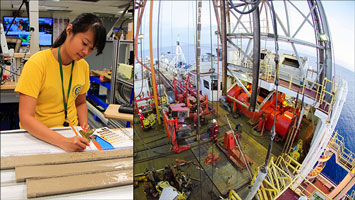 July 28, 2016 (Source: UM RSMAS) - A new study by an international team of scientists reveals the exact timing of the onset of the modern monsoon pattern in the Maldives 12.9 million years ago, and its connection to past climate changes and coral reefs in the region. The analysis of sediment cores provides direct physical evidence of the environmental conditions that sparked the monsoon conditions that exist today around the low-lying island nation and the Indian subcontinent.
July 28, 2016 (Source: UM RSMAS) - A new study by an international team of scientists reveals the exact timing of the onset of the modern monsoon pattern in the Maldives 12.9 million years ago, and its connection to past climate changes and coral reefs in the region. The analysis of sediment cores provides direct physical evidence of the environmental conditions that sparked the monsoon conditions that exist today around the low-lying island nation and the Indian subcontinent.
In Nov. 2015, University of Miami (UM) Rosenstiel School of Marine and Atmospheric Science geoscientist Gregor Eberli, along with his co-chief scientist Christian Betzler and an international team of 31 scientists from 15 countries, embarked on an eight-week expedition to the Maldives aboard the research vesselJOIDES Resolution. The scientific team on International Ocean Discovery Program (IODP) Expedition 359, which included UM geochemist Peter Swart and sedimentologist Anna Ling, extracted 3,097 meters of sediment cores that contain the history of the monsoon that is the most intense annually recurring climatic element on Earth. The monsoon system supplies moisture to the Indian subcontinent, which is important for the human population and vegetation in the region, as well as marine ecosystem in the surrounding seas.











